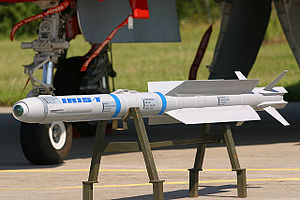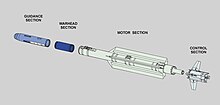IRIS-T
This article needs additional citations for verification. (June 2014) |
| IRIS-T | |
|---|---|
 1:1 model of the IRIS-T | |
| Type | Short-range air-to-air missile |
| Place of origin | German-led multinational armament program |
| Service history | |
| In service | December 2005 |
| Used by | See operators |
| Production history | |
| Manufacturer | Diehl BGT Defence |
| Unit cost | €0.38m[1] (~US$455,000) |
| Specifications | |
| Mass | 87.4 kg (193 lb) |
| Length | 2.9 m (9.5 ft) |
| Diameter | 127 mm (5.0 in) |
| Wingspan | 447 mm (17.6 in) |
| Warhead | HE/Fragmentation |
Detonation mechanism | Impact and active radar proximity fuse |
| Engine | Solid-fuel rocket |
Operational range | 25 km (16 mi) [2] |
| Flight altitude | Sea level to 20,000 m (66,000 ft) |
| Maximum speed | Mach 3 |
Guidance system | Infrared homing |
Launch platform | Typhoon, Tornado, F-4, F-16, NASAMS, Gripen, F-18. |
The IRIS-T (Infra Red Imaging System Tail/Thrust Vector-Controlled) is a German-led program to develop a short-range infrared homing air-to-air missile to replace the AIM-9 Sidewinder found in some NATO member countries. Any aircraft capable of firing the Sidewinder is also capable of launching the IRIS-T.
History


In the 1980s, NATO countries signed a Memorandum of Agreement that the United States would develop a medium-range air-to-air missile to replace the AIM-7 Sparrow, while Britain and Germany would develop a short-range air-to-air missile to replace the AIM-9 Sidewinder. The US design developed as the AIM-120 AMRAAM, while the UK-German design developed as the AIM-132 ASRAAM.[citation needed]
The roots of the ASRAAM dated back to 1968 when development began on the Hawker Siddeley SRAAM ('Taildog'), but this project ended in 1974 with no production orders. This work was dusted off for the UK/German effort, with the Germans providing a new seeker, and the British providing most of the remaining components. In the intervening time, the need for high maneuverability was downgraded in favor of greater range.[citation needed]
After German reunification in 1990, Germany found itself with large stockpiles of the Soviet Vympel R-73 missiles (NATO reporting name: AA-11 Archer) carried by the MiG-29 Fulcrum and concluded that the AA-11's capabilities had been noticeably underestimated.[3] In particular, it was found to be both far more maneuverable, and far more capable in terms of seeker acquisition and tracking than the latest AIM-9 Sidewinder.[4] In 1990 Germany withdrew from the ASRAAM project, while Britain resolved to find another seeker and develop ASRAAM according to the original requirements.[5]
In late 1990, the US partnership expressed similar concerns and embarked on an upgrade to the existing Sidewinder design to provide increased maneuverability and IRCCM (infrared counter counter measures) performance, i.e. measures to counter infrared countermeasures (IRCM). This program was designated AIM-9X.[6]
Missile characteristics
In comparison to the AIM-9L Sidewinder, the IRIS-T has higher ECM-resistance and flare suppression.[7] Improvements in target discrimination not only allows for 5 to 8 times longer head-on firing range than the AIM-9L, it can also engage targets behind the launching aircraft, the latter made possible by the extreme close-in agility allowing turns of 60 g at a rate of 60°/s.[8]
Development partners
In 1995, Germany announced the IRIS-T development program, in collaboration with Greece, Italy, Norway, Sweden and Canada. Canada later dropped out, while in 2003 Spain joined as a partner for procurement.[9] The German Air Force took first delivery of the missile on 5 December 2005.[10]
Workshare arrangements for IRIS-T development are:[11]
- Germany 46%
- Italy 19%
- Sweden 18%
- Greece 13%
- 4% split between Canada and Norway.
Variants
IDAS
The IDAS variant is a navalized version of the missile, is also being developed for the new Type 212 submarine of the German Navy. IDAS is supposed to engage air threats, small or medium surface vessels or near land targets.
-
Model of IDAS
IRIS-T SL
Within the MEADS program, the German Air Force plans to integrate a surface-launched (SL) radar-guided version of the missile, called IRIS-T SL. It has a pointed nose, unlike the regular IRIS-T.[12] The IRIS-T SL qualification tests were completed during January 2015 at the Denel Overberg Test Range in South Africa.[13] It is build in two variants IRIS-T SLS (short-range)[14] and IRIS-T SLM (medium-range).[15]
-
IRIS-T SL missile
-
IRIS-T SL launch system
SAM Version
The Swedish Army plans to develop a ground launched version of the IRIS-T to replace the RBS 70 missile system.[16]
The Norwegian Army is currently developing a self-propelled anti-aircraft system, combining IRIS-T missiles fired from existing NASAMS II-launchers mounted on a lengthened M113 chassis. Delivery is set for 2015.[17]
Operators

The following operators are listed and defined as of July 2008.
 Austria
Austria- 25[18]
 Belgium
Belgium- 500[citation needed]
 Germany
Germany- 1,250[18]
 Greece
Greece- 350[18]
 Italy
Italy- 444[citation needed] budget €217m, between 2003 and 2015.[19]
 Norway
Norway- 150[20]
 Saudi Arabia
Saudi Arabia- 1,400[21]
 South Africa
South Africa- 25 missiles delivered. Interim armament for Saab JAS 39 Gripen aircraft until the completion of the A-Darter SRAAM project.[22][23]
 Spain
Spain- 770 Original budget €247m, final cost €291m.[1]
 Sweden
Sweden- 400[18]
 Thailand
Thailand- Delivered, 220 to be ordered.[20]
See also
References
Notes
Citations
- ^ a b "Evaluación de los Programas Especiales de Armamento (PEAs)" (PDF). Atenea (in Spanish). Madrid: Ministerio de Defensa. September 2011. Retrieved 30 September 2012.
{{cite web}}: Unknown parameter|trans_title=ignored (|trans-title=suggested) (help) - ^ "Diehl Defence: IRIS-T, the short-distance missile of the latest generation". Diehl.com. Retrieved 11 March 2015.
- ^ Menon, KB. "Evolution of the Air-To-Air Missiles: Options for the IAF". Retrieved 11 June 2014.
- ^ "Locking range". Retrieved 11 June 2014.
- ^ Arms and the State: Patterns of Military Production and Trade. Cambridge University Press. 25 August 1995. 253. ISBN 0521558662.
{{cite book}}: Unknown parameter|nopp=ignored (|no-pp=suggested) (help) - ^ Tirpak, John. "The Evolution of the Force". Retrieved 11 June 2014.
- ^ "IRIS-T Guided Missile Family, Germany". Retrieved 11 June 2014.
- ^ "IRIS-T Air-to-Air Guided Missile, Germany". Retrieved 11 June 2014.
- ^ "IRIS-T". Retrieved 13 June 2014.
- ^ [1], 11 June 2014
- ^ [2] - typhoon.starstreak.net, 11 June 2014
- ^ "IRIS-T Guided Missile Family IRIS-T SL". Retrieved 17 June 2014.
- ^ "IRIS-T SL achieves qualification after successful firings at Overberg". defenceWeb. 10 February 2015. Retrieved 11 March 2015.
- ^ "IRIS-T SLS – surface-launched, short-range guided missile". Diehl Defence. Retrieved 9 June 2015.
- ^ "IRIS-T SLM". Deagel. Retrieved 9 June 2015.
- ^ More Air Launched Missiles Go To Ground - Strategypage.com, 26 January 2013
- ^ Rune Thomas Ege. "Hæren "pusset opp" for 15 milliarder - Forsvaret - VG". Vg.no. Retrieved 19 April 2014.
- ^ a b c d "South Africa Orders IRIS-T Missiles". Defense industry daily. Retrieved 17 June 2014.
- ^ "Nota Aggiuntiva allo stato di previsione per la Difesa per l'anno 2012" (PDF) (in Italian). Ministero delle Difesa. April 2012. Retrieved 19 April 2014.
- ^ a b "Diehl Defence: IRIS-T, the short-distance missile of the latest generation". Diehl.com. Retrieved 19 April 2014.
- ^ "Trade Registers". Armstrade.sipri.org. Retrieved 19 April 2014.
- ^ "Sipri: Trade Registers". Portal.sipri.org. Retrieved 11 March 2015.
- ^ "SAAF maintaining IRIS-T". defenceWeb. 23 May 2011. Retrieved 11 March 2015.
Bibliography
- Bonds, Ray ed. The Modern US War Machine. New York, New York: Crown Publishers, 1989. ISBN 0-517-68802-6.
External links



